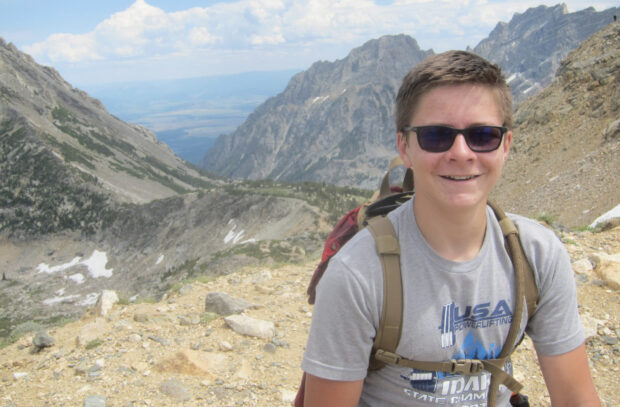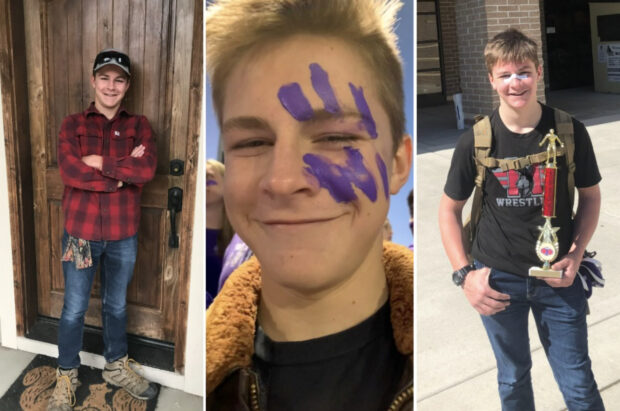
Nick Garvin seemed to be going through a rough patch of teenagerhood — a 14-year-old navigating the twists and turns of adolescence. He was a class clown, an athlete, a fan of classic rock. He was proud of his muscular build and his cowboy hat.
Nick died by suicide last November. He was a freshman at Rocky Mountain High School in Meridian.
It is rare for a child to die — and rarer still for a child to die by suicide. But one preventable death is a tragedy, and Nick Garvin’s parents want to open a conversation about the tragic reality that struck their family. They want other parents to know: This could happen to any family. What seems like a bit of teen angst could be just that, or it could be a sign that a child is considering suicide.
“It’s not limited to the moody, dark kid in the back of the class. I don’t think there’s any real, stereotypical kid,” said Roberta Garvin, his mother.
In hindsight, there were warning signs, but they were subtle — and not uncommon among teens.
“He did have … dark moments that we thought were much more under control,” she said.
‘He would not let us in’
Chris and Roberta Garvin had noticed their son becoming withdrawn. But he reassured his parents that everything was fine. He still hung out with friends, kept up his grades and worked toward goals.
“He seemed to be doing amazing,” said Chris. “We thought he had a really, really good transition to high school, he had lots of friends, and he was going out to football games and to stake dances (with friends who were Latter-day Saints). … And I mean, he was just having a blast by all outward signs.”
Warning signs that a person is at risk of suicide include withdrawing, changes in behavior, quitting some of their favorite activities, and seeming to feel a lot of pressure and expectations in their life, said Teresa Abbott, who heads Idaho’s Suicide Prevention Program.
“There is a perception that we shouldn’t talk about (suicidality) and make things worse, and that’s actually the opposite of what national research indicates. It really is,” she said. “Suicide is preventable, and the most important thing a parent can do is talk to their kids and ask; it’s OK to ask that direct question.”
Even though he was close with his parents, when Nick was suffering emotionally before his suicide, “he would not let us in. Like, no matter how many times we asked, the answer was, ‘I’m OK. I got this. I’m good,’” Roberta said in an interview in December.
Chris now wonders: Did his son have a “20-minute pitch” prepared for when someone asked how he was? Was he holding it together just long enough to seem upbeat for 20 minutes, before going to his room and listening to sad music?
There were hints that Nick was struggling with low self-esteem, feeling lonely and friendless. From the outside looking in, his parents say, Nick was gregarious and self-driven and had countless friends.

But he would make fleeting comments that his friends didn’t really like him, that he didn’t really belong.
“Nick struggled with unexplainable feelings of sadness and loneliness in his last months, and wouldn’t let his friends and family help him feel loved or connected,” his obituary says. Nick’s parents wanted his friends to know: Nick’s suicide wasn’t something they caused.
Suicide is not caused by one event, one person or one issue. Many people experience loneliness, mental illness, depression and anxiety — and they survive. They get help from a trusted adult or a mental health professional, and things get better. They find hope.
“There’s a lot of things I wish we did differently,” said Roberta Garvin, Nick’s mother. “(What) would have been helpful … is pushing the conversation more when we said, ‘You need to talk to somebody,’ and not just ending the conversation. Then, like, ‘OK, who are you talking to?’ And then even double checking with that person.”
A couple of months before his death, the Garvins talked with Nick about going to counseling.
He’d gone through counseling as a child, and again right before the sixth grade, they said.
“And for whatever reason we decided not to,” Roberta said.
Parents, families need support
The Garvins said their community helped them after Nick’s death — especially their neighbors who belong to The Church of Jesus Christ of Latter-day Saints, which gave them a place to hold a memorial for Nick and offered them support, even though the Garvins themselves weren’t members of the church.
Still, the death of a child brought questions and concerns they never imagined. Knowing these questions and concerns can arise may help friends and family support parents after the unexpected loss of a child:
How do you get through the holidays?
What do you do about the child’s bedroom and belongings?
How do you process all the reminders in daily life?
Will people judge you if you enjoy yourself in public ‘too soon’ for a grieving parent?
How can you best support your other child or children?
How do you plan a funeral, manage insurance and paperwork, the coroner’s office and death certificate, and all the other things that death requires — and still have time and energy to grieve and to heal?
Then, the appointments for therapy and counseling: Where do you start?
Suicide is rare. But it is a public health crisis.
The summer before Nick’s freshman year, he seemed to be a little more moody than usual, the Garvins said. As swim season was ending, he broke up with his girlfriend. He’d wrestled for years, but after going to a few practices that fall, he decided not to return to the wrestling team.

“I mean, everything’s Earth shattering when you’re 14, but nothing (happened) that, in retrospect, was Earth shattering,” said Chris Garvin.
There were other signs of what was to come.
Nick had confided in his older sister, Allie, that he was thinking about taking his own life, a couple years earlier. That’s when he started counseling for the second time. But again, in May or June 2021, the Garvins went through Nick’s search history and saw he was looking up information about suicide.
“And he’s like, ‘Nah, I was going through some bad times a couple days ago, but it’s all fine now,’” Chris Garvin recalled, adding that he urged Nick to “talk to somebody,” even if the somebody wasn’t his parents.
At the time, they were trying to walk “that line between (letting him solve) his own problems and intervening where you need to intervene,” Chris said.
Abbott, the state’s suicide prevention director, said parents can open the conversation with an observation that they “really seem to be struggling” and to ask, “Have you thought about suicide? Have you made a plan?”
She also recommends calling the Idaho Crisis & Suicide Hotline, which can help parents figure out what to do if they think their child is considering suicide or experiencing a mental health crisis.
“The main thing that we want to let parents know is: You should talk about mental health issues the same way you talk about any other health issue,” Abbott said. “Don’t be afraid to ask those questions. It’s not going to plant an idea or make a person more likely to (die by suicide).”
Idaho lost six children and 132 teens to suicide in the years 2014 through 2020, according to the Idaho Department of Health and Welfare’s Division of Public Health.
Idaho’s suicide rate among youth was highest in 2018 and then “declined fairly substantially” in 2019 and 2020, Abbott said. It usually takes at least six months to gather final data for the prior year, but preliminary data for 2021 shows youth suicide rates continued at a lower level like that of 2019 and 2020, Abbott said.
“When there’s a loss in a youth community, it’s just so hard on everybody,” she said. “The loss goes way beyond just the loss of that one young person. It hurts all of us, and has lasting repercussions on friend groups and parents and coaches and teachers.”
There were zero deaths by suicide in the West Ada School District in the 2020-21 school year — in spite of the stressors on students, teachers and parents that year.
This school year, though, three West Ada students died by suicide as of late March.
The Garvins do not believe Nick’s suicide was related to the pandemic. His home life, school life and social life weren’t radically changed by COVID-19.
The past few years have been hard on teens
For some high school students, though, the disruptions and upheavals caused by the pandemic do seem to have taken a toll on mental health.
“The worsening mental health of youth was a growing public health issue even before America had ever heard of COVID-19,” Dr. Jonathan Mermin, director of the CDC’s National Center for HIV, Viral Hepatitis, STD and TB Prevention, said in a CDC telebriefing. “Data from high school students around the country already signaled a problem, with more students saying they felt sad, hopeless and more students attempting suicide in the decade prior to the pandemic.”
Federal data showed an increase in suicidal thoughts or actions among U.S. high school students between 2009 and 2019.
Researchers conducted a national survey of high school students in January through June 2021. The survey found extraordinary levels of stress in families and homes: job loss, abuse, not enough food, illness or death of a caregiver and other adverse childhood experiences.
About 20% of students said they’d contemplated suicide, and 9% of students said they’d attempted it, in the 12 months before the survey.
The survey found a higher rate of serious distress among LGBTQ+ youth, and more than half of Asian and Black students reported racism at school, which researchers speculated may have been worsened by stigma related to the pandemic.
But the survey also seemed to present a solution, Mermin said.
Teens who felt connected to others in school were less likely to feel mental distress, hopelessness or to feel suicidal or attempt suicide — even if their connections were virtual.
“There is no aspect of society that should not be working together to try to support our young people as they move forward,” said Kathleen A. Ethier, director of the CDC’s Division of Adolescent and School Health.
The study found that students who reported “school connectedness” — feeling cared for, supported and a sense of belonging — fared better when it came to mental health.
Students who felt connected to adults and peers at school were significantly less likely to report persistent feelings of sadness or hopelessness (35% versus 53% for students who felt disconnected). They were less likely to have seriously considered attempting suicide (14% versus 26%); or attempted suicide (6% versus 12%).
But, only 47% of youth reported feeling close to people at school during the pandemic.
“School connectedness is a key to addressing youth adversities at all times — especially during times of severe disruptions,” Ethier said. “Students need our support now more than ever, whether by making sure that their schools are inclusive and safe or by providing opportunities to engage in their communities and be mentored by supportive adults.”
How to help Idaho’s children and teens at risk of suicide?
Teachers and mental health professionals are working on ways to help reach students before they are in crisis.
One program that can be helpful for parents is the QPR — Question, Persuade, and Refer — Gatekeeper Training for Suicide Prevention.
The training is one to two hours, “designed to teach lay and professional ‘gatekeepers’ the warning signs of a suicide crisis and how to respond,” according to the Suicide Prevention Resource Center.
QPR training covers three steps, the SPRC says:
- Question the person’s desire or intent regarding suicide.
- Persuade them to seek and accept help.
- Refer them to appropriate resources.
The training is available online at qprinstitute.com for $30 for individuals (discounts for government employees, military and students) and is available in-person or online for organizations and professionals.

The West Ada School District superintendent has taken two steps to try to address mental health in schools, according to spokesperson Niki Scheppers.
First, all counselors are going through a program called Sources of Strength — a training meant to build resilience, help students recognize their own sources of strength and foster peer-to-peer connections. The training used to be optional but is now a requirement, Scheppers said.
The superintendent also has staff going through Idaho Lives training specific to suicide prevention, “to know what trigger and caution signs to share with parents, as well,” Scheppers said.
“I think parents, at the secondary (school) age, tend to pull away because we want our children to become autonomous and mature,” she said. “But that’s sometimes when they need us the most.”
That is one of the delicate boundaries the Garvins tried to navigate. They were attentive to their kids. They were interested in their lives, in and out of school. They went on family vacations around the world. They tucked their children into bed every night, even when they reached adolescence.
“He was very quiet in the morning. ‘OK, is he just not a morning person? Or is he moody? Or is he depressed?’ I mean, you know, obviously, I didn’t know,” Roberta Garvin said. “When you’ve got teenagers, you’re constantly trying to find the line between normal teenage moodiness and letting them get through it and work through whatever’s going on in their heads; and helping them with things that are … too big for them.”
Suicide warning signs and risk factors
While there is no single cause for suicide, there are risk factors and warning signs which may indicate an increased likelihood someone could be at risk for suicide.
Learning risk factors and warning signs can save lives.
People thinking of suicide often display one or more of the following moods:
- Depression
- Anger
- Anxiety
- Apathy
- Irritability
- Guilt
- Shame
People thinking of suicide often communicate (sometimes veiled in humor) thoughts of:
- Wanting to kill themselves
- Feeling hopeless
- Having no reason to live
- Being a burden to others
People thinking of suicide often display behaviors that may signal risk:
- Noticeable changes in eating or sleeping habits
- Withdrawing from family or friends or activities
- Increased use of alcohol or drugs
- Visiting or calling people to say goodbye
- Giving away valued possession
- Searching the internet for ways to die by suicide
A history of suicide attempts, or a personal connection to someone who has suicided are both risk factors for suicide.
If you have concerns about someone or they display any of these warning signs, we encourage you to share your concerns with them, let them know you care and ask them directly if they are thinking of suicide. (Source: Idaho Crisis & Suicide Hotline)
